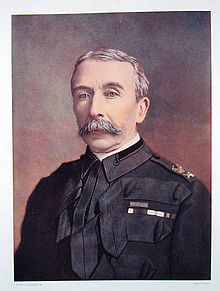| Sir Edward Chapman | |
|---|---|
 Sir Edward Chapman Sir Edward Chapman | |
| Born | (1840-11-14)14 November 1840 Calcutta, India |
| Died | 12 May 1926(1926-05-12) (aged 85) Limpsfield, Surrey |
| Allegiance | |
| Service | |
| Years of service | 1858–1906 |
| Rank | General |
| Unit | Bengal Artillery Royal Artillery |
| Commands | Colonel Commandant Royal Artillery Scottish District |
| Battles / wars | British Expedition to Abyssinia Second Anglo-Afghan War Third Anglo-Burmese War |
| Awards | Knight Commander of the Order of the Bath Mentioned in Dispatches |
| Other work | Geographer |
General Sir Edward Francis Chapman KCB FRGS (14 November 1840 – 12 May 1926) was a senior British Army officer who commanded the Army in Scotland and was the ceremonial head of the Royal Regiment of Artillery.
Military career
He was commissioned into the Bengal Artillery in 1858, which was later amalgamated into the Royal Artillery. He quickly caught the attention of Sir Frederick Roberts who predicted that Chapman would "make his mark". He was duly selected to fight in the British Expedition to Abyssinia between 1867 and 1868 as the commander of No. 5 Battery, 21st Brigade. He was present at the action of Arogee and at the fall of Magdala, working as aide-de-camp to Brigadier-General Petrie and being mentioned in dispatches for his services. Chapman was part of a mission to Yarkand in China in 1874. He served in the Second Anglo-Afghan War from 1878 to 1880, and was Sir Frederick Roberts' Chief of Staff during the march from Kabul to Kandahar.
He was appointed Military Secretary to the Commander-in-Chief, India in 1881 and went on the Burma expedition in 1885. He was Quartermaster-General for India from 1885 to 1889, and introduced a system of organised native brothels for British other ranks in the hope of reducing the incidence of venereal diseases. He became the second Director of Military Intelligence at the War Office in 1891. He was aide-de-camp to Queen Victoria in 1891. As an active member of the Royal Geographical Society, he presented several lectures and wrote numerous papers on the effects of physical geography on the tactics and success of military operations. Additionally, he wrote several books about military geography and the history of the British Indian Army. He was promoted to major-general in 1889, lieutenant-general in 1892, and general in March 1896. Chapman was made Commander Scottish District in 1896, a post he held until 1901. He was made a Knight Commander of the Order of the Bath in 1905 and retired in 1906. He was Master Gunner, St James's Park, the ceremonial commander of the Royal Artillery, between 1919 and 1926.
Personal life
On 3 December 1886 he married Georgiana Bayley, daughter of Edward Clive Bayley.
He lived at Limpsfield in Surrey. He was an Esquire of the Venerable Order of Saint John and a member of the Athenaeum Club, London.
The Anglican priest and London County Council member the Rev Hugh Boswell Chapman was a younger brother.
References
- "Who's Who 1914". Retrieved 4 November 2014.
- ^ Liddell Hart Centre for Military Archives
- "Yarkund Mission, 1873. - View in Bazar, Leh. 355190". British Library. Retrieved 22 September 2014.
- "Edward Francis Chapman photographs of Yarkand and Kashgar, 1873-1874". Getty Research Institute. hdl:10020/cifa2017r16. Retrieved 14 November 2020.
- Philippa Levine, Prostitution, Race, and Politics: Policing Venereal Disease in the British Empire (Psychology Press, 2003), 96-7.
- "Who's Who 1914". Retrieved 4 November 2014.
- "No. 25054". The London Gazette. 30 December 1881. p. 6929.
- E. F. Chapman, Lecture on Physical Geography in Its Relation to Military Operations (Kessinger Publishing, 2010)
- Chapman, Edward Francis. "Google booklist". Retrieved 22 September 2014.
- "Who's Who 1914". Retrieved 4 November 2014.
- "No. 27312". The London Gazette. 10 May 1901. p. 3202.
- "No. 27926". The London Gazette (Supplement). 29 June 1906. p. 4459.
- "Celebrities of the Army". Anglo-Afghan War. Retrieved 22 October 2014.
- ^ The Templehouse Papers
- "Who's Who 1914". Retrieved 4 November 2014.
- "Who's Who 1914". Retrieved 4 November 2014.
- "Dod's Peerage". Retrieved 22 August 2014.
- Hughes-Hughes, WO, The Register of Tonbridge School from 1820 to 1893, (1893: Richard Bentley) p 141.
External links
- Edward Francis Chapman photographs of Yarkand and Kashgar, 1873-1874, Getty Research Institute, Los Angeles, Accession no. 2017.R.16. The album of 90 photographs documents the information gathering mission from Leh, India to Yarkand (Shache) China led by Sir T. D. Forsyth in 1873. The photographs portray the southern branch of the Silk Road and its routes, and are the first photographic record made of the indigenous inhabitants of Chinese Turkistan.
| Military offices | ||
|---|---|---|
| Preceded byHugh Rowlands | GOC Scottish District 1896–1901 |
Succeeded byArchibald Hunter |
| Preceded byHenry Brackenbury | Director of Military Intelligence 1891–1896 |
Succeeded byJohn Charles Ardagh |
| Honorary titles | ||
| Preceded byFrancis Ward | Master Gunner, St James's Park 1919–1926 |
Succeeded byLord Horne |
- 1840 births
- 1926 deaths
- Bengal Artillery officers
- British Army generals
- British historians
- British military personnel of the Second Anglo-Afghan War
- Esquires of the Order of St John
- Fellows of the Royal Geographical Society
- Graduates of the Royal Military Academy, Woolwich
- Graduates of the Staff College, Camberley
- Knights Commander of the Order of the Bath
- Military personnel from Kolkata
- Royal Artillery officers
- British military personnel of the Abyssinian War
- British military personnel of the Third Anglo-Burmese War
- 19th-century British Army personnel
- 20th-century British Army personnel